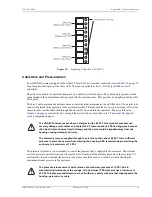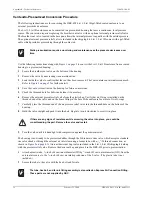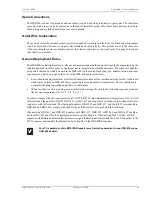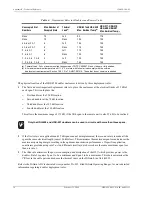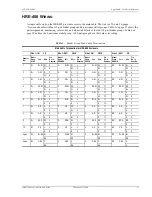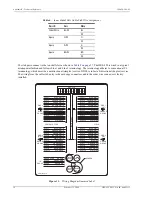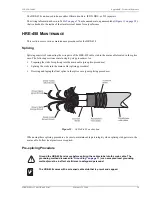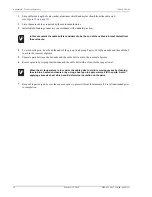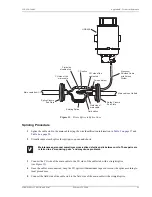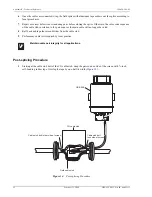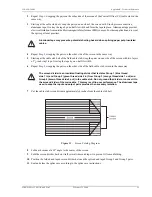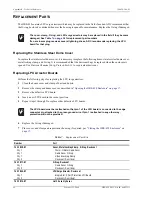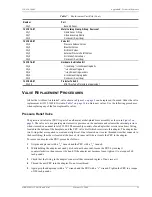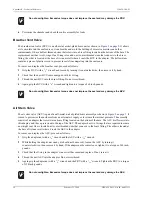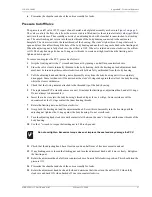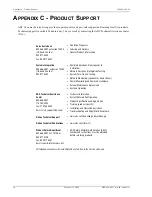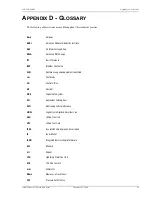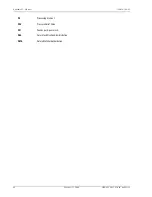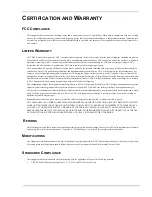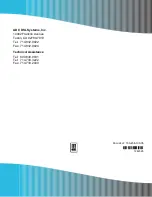
150-458-100-05
Appendix B - Technical Reference
HRE-458 List 1, List 1B, and List 2
February 23, 2000
37
6
Pressurize the chamber and check the entire assembly for leaks.
Pressure Cutoff Valve
The pressure cutoff valve (PCV) is part of an all-metal, nickel-plated assembly as shown in
.
The valve controls the flow of air from the air core stub (air-filled unit) or the external air inlet valve ((gel-filled
unit) into the enclosure. The assembly consists of an adjusting knob with stem that is inner-locked to a limiting
nut. The outer limiting nut screws into the outer threads of the body housing connected to the enclosure’s
baseplate. The stem screws into the inner threads of the housing. The stem’s tip has three O-rings that work to
open and close the airflow through the base of the body housing and another O-ring embedded in the limiting nut.
When the adjusting nut is fully clockwise, the airflow is OFF. When it is rotated one turn clockwise, the airflow
is ON. The body housing also has an O-ring on its threads to create an airtight seal when the limiting nut is
tightened down upon it.
To remove and replace the PCV, proceed as follows:
1
Grip the limiting nut with a 1” wrench and loosen it by turning one-half turn counterclockwise.
2
Since the valve stem is internally threaded to the body housing, both the limiting nut and adjustment knob
must next be turned together counterclockwise until both are fully unthreaded from the body housing.
3
Pull the adjusting knob and limiting nut subassembly away from the body housing until it is completely
disengaged. Some resistance will be noticed as the stem’s O-rings rub against the walls of the body housing
while the stem is withdrawn.
4
Check that the O-ring remains attached to the threaded tip of the body housing.
5
The replacement PCV assembly comes as a unit. It includes the limiting nut, adjustment knob, and all O-rings.
Do not attempt to disassemble it.
6
Insert the valve stem into the body housing’s threaded tip as far as it will go. Some resistance will be
encountered as the O-rings contact the inner housing threads.
7
Rotate the limiting nut one-half turn clockwise.
8
Grasp both the limiting nut and the adjustment knob. Screw this subassembly into the housing until the
adjusting nut tightens the O-ring against the body housing. Do not crossthread.
9
Turn the adjusting knob clockwise until contact is felt between the stem’s O-rings and the inner threads of the
body housing.
10 Use the 1” wrench to torque the limiting nut to 200 inch-pounds.
11 Check that the adjusting knob has at least one and one-half turns of free movement in and out.
12 If any binding occurs, loosen the limiting nut and turn the adjustment knob until it moves freely. Retighten
the limiting nut.
13 Rotate the adjustment knob a full turn counterclockwise from its full clockwise position. This should turn the
pressure ON.
14 Pressurize the chamber and check the entire assembly for leaks.
15 Rotate the adjustment knob back and forth and determine that it does turn the airflow OFF when fully
clockwise and back ON when backed off one turn counterclockwise.
Do not overtighten. Excessive torque does not improve the seal and may damage the PCV.

